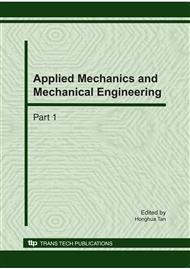[1]
Reed M, Aamo O M, Real time oil spill forecasting during an experimental oil spill in the Arctic ice, Spill Science and Technology Bulletin, vol 1, 1994, pp.69-77.
DOI: 10.1016/1353-2561(94)90009-4
Google Scholar
[2]
Per Johan Brandvik, Liv-Guri Faksness, Weathering processes in Arctic oil spills: Meso-scale experiments with different ice conditions, Cold Regions Science and Technology, vol 55, 2009, pp.160-166.
DOI: 10.1016/j.coldregions.2008.06.006
Google Scholar
[3]
Song-ping Zhu, Dmitry Strunin, A numerical model for the confinement of oil spill with floating booms, Spill Science & Technology Bulletin, vol 7, 2002, pp.249-255.
DOI: 10.1016/s1353-2561(02)00042-7
Google Scholar
[4]
S.D. Wanga, Y.M. Shena, Y.H. Zheng, Two-dimensional numerical simulation for transport and fate of oil spills in seas, Ocean Engineering, vol 32, 2005, pp.1556-1571.
DOI: 10.1016/j.oceaneng.2004.12.010
Google Scholar
[5]
P Vethamony, K Sudheesh et al., Trajectory of an oil spill off Goa, eastern Arabian Sea: Field observations and simulations, Environmental Pollution, vol 148, 2007, pp.438-444.
DOI: 10.1016/j.envpol.2006.12.017
Google Scholar
[6]
Xiaobo Chao, N. Jothi Shankar, Hin Fatt Cheong, Two- and three-dimensional oil spill model for coastal waters, Ocean Engineering, vol 28, 2001, pp.1557-1573.
DOI: 10.1016/s0029-8018(01)00027-0
Google Scholar
[7]
P Sebastião, C Guedes Soares, Uncertainty in predictions of oil spill trajectories in a coastal zone, Journal of Marine Systems, vol 63, 2006, pp.257-269.
DOI: 10.1016/j.jmarsys.2006.06.002
Google Scholar
[8]
W J Guo, Y X Wang, A numerical oil spill model based on a hybrid method, Marine Pollution Bulletin, vol 58, 2009, pp.726-734.
DOI: 10.1016/j.marpolbul.2008.12.015
Google Scholar
[9]
J Papadimitrakis, M Psaltaki, M Christolis, N C Markatos, Simulating the fate of an oil spill near coastal zones: The case of a spill at the Greek Island of Lesvos, Environmental Modelling & Software, vol 21, 2006, pp.170-177.
DOI: 10.1016/j.envsoft.2004.04.020
Google Scholar
[10]
P Sebastião, C Guedes Soares, Uncertainty in predictions of oil spill trajectories in open sea, Ocean Engineering, vol 34, 2007, pp.576-584.
DOI: 10.1016/j.oceaneng.2006.01.014
Google Scholar
[11]
Øistein Johansen, Henrik Rye, Cortis Cooper, Deepspill-field study of a simulated oil and gas blowout in deep water, Spill Science & Technology Bulletin, vol 8, 2003, pp.433-443.
DOI: 10.1016/s1353-2561(02)00123-8
Google Scholar
[12]
Lalith K Dasanayaka, Poojitha D Yapa, Role of plume dynamics phase in a deepwater oil and gas release model, Journal of Hydro-environment Research, vol 2, 2009, pp.243-253.
DOI: 10.1016/j.jher.2009.01.004
Google Scholar
[13]
Liu Jin-kun, Hu Hong-qin, The design of submarine pipeline in chengdao oil field, China Offshore Platform, vol 11, 1996, pp.214-217.
Google Scholar
[14]
Zhao Shuai, Liu Jin-kun, Submarine Pipeline Design of Chengdao Oilfield, Oil & Gas Storage and Transportation, vol 16, 1997, pp.32-36.
Google Scholar


